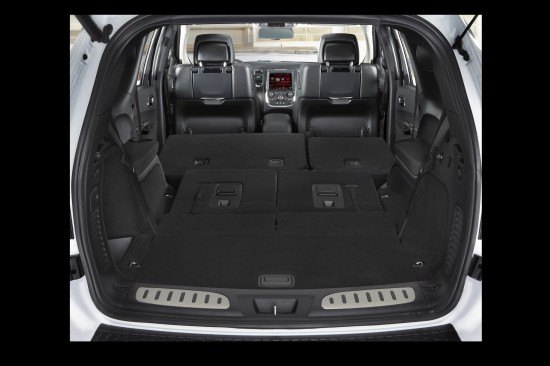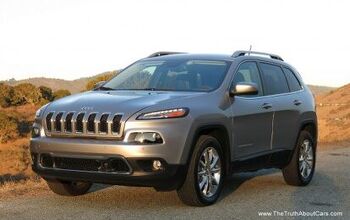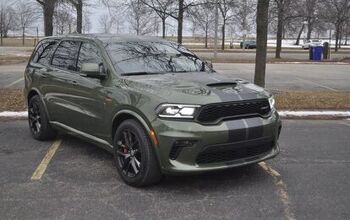Review: 2014 Dodge Durango Limited V8 (with Video)

Car shopping used to be so simple: you could buy a truck or a car. Then came the wagon, minivan, sport utility and the latest craze: the crossover. There’s just one problem with the crossover for me however: it’s not a crossover. With a name like that you’d assume that a modern crossover blended the lines between a truck/SUV with a car/minivan. The reality of course is that the modern three-row crossover is just a front-driving minivan that doesn’t handle as well or haul as much stuff. In this sea of transverse minivans in SUV clothing lies just one mass-market vehicle that I can honestly call a three-row crossover: the Dodge Durango. Instead of a car that’s been turned into an AWD minivan with a longer hood, the Dodge uses drivetrains out of the RAM 1500 combined with a car-like unibody. While rumors swirled that the Durango would be canceled in favor of a 7-seat Jeep, Dodge was working a substantial makeover for 2014.
So what is the Durango? Is it an SUV? Is it a crossover? In my mind, both. If a Grand Cherokee can be a unibody SUV and not a crossover, the Durango must be an SUV. But if a crossover is a hybrid between a car and a truck, then the Durango is one as well. While the first and second generation Durangos were body-on-frame SUVs based on the Dakota pickup, this Durango is a three-row Grand Cherokee, which is a two-row Jeep version of the three-row Mercedes ML which is quasi related to the Mercedes E-Class, which is quasi related to the Chrysler 300. Lost yet?
Exterior
2014 brings few changes to the outside of the Durango. The design first released in 2011 still looks fresh to my eye but that could be because I don’t see many on the road. Up front we get a tweaked corporate grille and new lamps while out back we get “race track” inspired light pipes circling the rump. Aside from a lowered right height on certain models and new wheels, little has changed for the Durango’s slab-sided profile, which I think is one of the Dodge’s best features. No, I’m not talking about the plain-Jane acres of sheet metal, I’m talking about RWD proportions. Bucking the trend, this three-row sports a long (and tall) hood, blunt nose, short front overhang and high belt-line.
To create the Durango from the Grand Cherokee, Chrysler stretched the Jeep’s wheelbase by 5-inches to 119.8 inches and added three inches to the body. The result is four-inches longer than an Explorer but two inches shorter than the Traverse, Acadia and Enclave triplets. Thanks to the Durango’s short front overhand, the Dodge has the longest wheelbase by a long way, beating even the full-size Chevy Tahoe. Speaking of the body-on-frame competition, the Durango may have been a size too small in the past, but this generation is just 8/10ths of an inch shorter than that Tahoe.
Interior
Body-on-frame SUVs have a practicality problem when it comes to space efficiency. Because the frame sits between the body and the road, they tend to be taller than unibody crossovers despite having less interior volume. Like the rest of the crossover crowd, this allows the Durango to have a spacious interior with a comparatively low entry height. 2014 brings a raft of much-needed interior updates to the cabin including a new soft touch dashboard, Chrysler’s latest corporate steering wheel with shift paddles, revised climate controls, Chrysler’s latest uConnect 2 infotainment system and a standard 7-inch LCD instrument cluster. Like the other Chrysler products with this LCD, the screen is flanked by a traditional tachometer, fuel and temperature gauge. Oddly enough, the standard infotainment screen is a smallish (in comparison) 5-inches.
Front seat comfort proves excellent in the Durango which was something of a relief, as the last few Chrysler products I have driven had form and oddly shaped seat bottom cushions that make me feel as if I was “sitting on and not in the seat.” As with all three-row vehicles, the accommodations get less comfortable as you move toward the back. By default all Durango trims are 7-passenger vehicles with a three-across second row. For $895 Dodge will delete the middle seat and insert a pair of more comfortable captain’s chairs and a center console with cup holders and a storage compartment. The third row is a strictly two-person affair and, like most crossovers, is best left to children and your mother in law. Those who do find themselves in “the way back” will be comforted by above average headroom and soft touch plastic arm rests. With large exterior proportions you’d expect a big cargo hold like in the cavernous Traverse, alas the RWD layout that makes the Durango so unique renders the interior less practical. With more of the body used up for “hood,” we get just 17 cubes of space behind the third row. That’s three less than an Explorer, seven less than GM’s Lambda triplets and about the same as a Honda Pilot. On the bright side this is more than you will find in a Highlander or Sorento and shockingly enough, more than in the Tahoe as well.
Infotainment
uConnect 2 is the first major update to Chrysler’s 8.4-inch touchscreen system that launched in 2011 and the first version of this system the Durango has ever had. Based on a QNX UNIX operating system, the system features well polished graphics, snappy screen changes and a large, bright display. For the second edition of uConnect, Chrysler smoothed out the few rough edges in the first generation of this system and added a boat-load of trendy tech features you may or may not care about. In addition to improved voice commands for USB/iDevice control, uConnect 2 offers smartphone integration allowing you to stream audio from Pandora, iHeart Radio or Slacker Radio. You can have text messages read to you and dictate replies (if your phone supports it) and search for restaurants and businesses via Yelp. In addition to all the smartphone-tied features, uConnect 2 integrates a CDMA modem on the Sprint network into the unit for over-the-air software updates and access to the new “App Store” where you will be able to buy apps for your car. Since there’s a cell modem onboard, uConnect can be configured to act as a WiFi hot spot for your tablets and game devices as well. Keep in mind speeds are 3G, not Sprint’s WiMAX or LTE network.
Completing the information assault is SiriusXM’s assortment of satellite data services which include traffic, movie times, sports scores, fuel prices and weather reports. As with uConnect data services, there’s a fee associated after the first few months so keep that in mind. 2014 also brings uConnect Access which is Chrysler’s answer to GM’s OnStar providing 911 assistance, crash notification and vehicle health reports. Garmin’s navigation software is still available as a $500 add-on (standard on Summit) and it still looks like someone cut a hole in the screen and stuck a hand-held Garmin unit in the dash. The interface is easy to use but notably less snazzy than the rest of the system’s graphics. If the bevy of USB ports has you confused, you can rock your Cat Stevens CD by paying $190 for a single-slot disc player jammed into the center armrest.
Dodge shoppers will find two of the Grand Cherokee’s four engines under the hood. First up we have a 290HP/260lb-ft 3.6L V6 (295HP in certain trims) standard in all trims except the R/T. R/T models get a standard 360HP/390lb-ft 5.7L HEMI V8 which can be added to the other trims for $2,795. 2014 brings a beefed up cooling system and a number of minor tweaks in the name of fuel economy. Sadly Chrysler has decided to keep the V6 EcoDiesel engine and 6.4L SRT V8 Grand Cherokee only options, so if you hoped to sip diesel or burn rubber in your three row crossover, you’ll need to look elsewhere.
Both engines are mated to a ZF-designed 8-speed automatic. V6 models use the low torque variety made by Chrysler while V8 models use a heavy-duty 8HP70 made in a ZF factory. If you’re up to date on Euro inbreeding, you know this is the same transmission used by BMW, Audi, Jaguar, Land Rover and Rolls Royce. To say this is a step up from the vilified Mercedes 5-speed or the Chrysler 6 speed (the 65RFE featured some of the strangest ratio spacing ever) is putting it mildly. Fuel economy jumps 9% in the V6, 10% in the V8. No small feat in a 4,835lb SUV (as tested). All Durangos start out as rear wheel drive vehicles but you can add a two-speed four-wheel-drive system for $2,400. Although Dodge bills this as AWD, it is the same transfer case that Jeep calls 4×4 in Selec-Trac II equipped Grand Cherokees. Thanks to the heavy-duty drivetrain towing rings in at 6,200lbs for the V6 and 7,400lbs for the V8. Like the Jeeps the Durango has moved to more car-like 5-lug wheels which should widen after-market selection.
Drive
The engineers took the refresh opportunity to tweak the Durango toward the sportier side of the segment with stiffer springs and beefier sway bars. While far from a night-and-day transformation, the difference is noticeable and appreciated out on the roads. While never harsh, it is obvious the Durango is tuned towards the firm side of this segment. Thanks to the long wheelbase the Durango feels well composed on the highway or on broken pavement.
With a nearly 50/50 weight balance, wide 265-width tires, and a lower center of gravity than a “traditional SUV”, the Durango is easily the handling and road feeling champion. That’s not to say the Durango is some sort of sports car in disguise, but when you compare a well balanced 360 horsepower rear wheel drive elephant to a slightly lighter but much less balanced front driving elephant on skinny rubber, it’s easy to see which is more exciting. Thanks to the Mercedes roots there’s even a whiff of feedback in the steering, more than you can say for the average crossover. Despite the long wheelbase and wide tires, the Durango still cuts a fairly respectable 37-foot turning circle.
Those statement may have you scratching your head if you recall what I said about Jeep on which the Durango is based, I must admit I scratched my head as well. Although the Dodge and the Jeep share suspension design elements and a limited number of components, the tuning is quite different. The Grand Cherokee Summit rides 3.1-inchs higher and was equipped with the off-road oriented air suspension.
When it comes to performance, the new 8-speed automatic makes a night and day difference shaving a whopping 1.4 seconds off the 0-60 time versus the last V8 Durango we tested. The reason is all in the gear ratios. While the 545RFE and 65RFE transmissions suffered from some truly odd ratios, the ZF unit’s ratios are more evenly spread and dig deeper in the low gears. The result is a 6.0 second sprint to highway speeds which finally nips on the tails of the Explorer Sport which we’re told will do the same in 5.9-6.0 (TTAC hasn’t tested one yet). This proves what extra gears can do for you because the Explorer is 200lbs lighter and has a far more advantageous torque curve thanks to the twin turbos.
You can also thank the ZF transmission for the Durango’s robust towing numbers. V6 models are now rated for 6,200lbs while the V8 can haul up to 7,400lbs when properly equipped. That’s nearly 50% more than you can tow in any of the crossover competition and just 1,000 lbs shy of the average full-size body-on-frame hauler.
The transmission is also responsible for a whopping 20% increase in fuel economy. The last V8 Durango I tested eked out a combined 14.8 MPG over a week while the 2014 managed 18.0 MPG. While 18 MPG isn’t impressive in wider terms, it is 1/2 an MPG better than GM’s Lambda crossovers or the Ford Explorer on my commute cycle. The V6 yields improved fuel economy at the expense of thrust, but you should know that although the acceleration provided by the V6 is competitive with the V6 three-row competition, the 20 MPG average falls short of the new Highlander, Pathfinder and the rest of the FWD eco-minded competition.
After a week with the Durango I was no closer to answering the biggest question car buffs have: is this Dodge a crossover or an SUV? One thing is sure however, the Durango is likely the most fun you can have with 6 of your friends for under $50,000.
Chrysler provided the vehicle, insurance and one tank of gas for this review.
Specifications as tested:
0-30: 2.4
0-60: 6.0
1/4 Mile: 14.6 Seconds @ 96 MPH
Cabin noise at 50 MPH: 69dB @ 50 MPH
Average observed fuel economy: 18 MPG over 811 miles

More by Alex L. Dykes
Latest Car Reviews
Read moreLatest Product Reviews
Read moreRecent Comments
- Lou_BC This is the sort of thing that lands 15 billion dollar Honda investments in Canada. One political party tries to undo everything the other one has done.
- Ajla "Mr Musk needs to go" "should not be CEO anymore."It isn't exactly easy getting rid of someone that owns 20.5% of the company (likely 25% by year's end), is one of the wealthiest people on Earth and has a giant media presence. Elon's only stepping down if he or God makes the decision.
- Lou_BC I like the colour. That's about it.
- Lou_BC I'd say Mr. Musk needs to lay off the ketamine.
- Lua65789308 Laundering Federal money can make anyone very wealthy.























































Comments
Join the conversation
I have an uncle who put over 150,000 miles on his 09' Navigator that would abandon Lincoln, run out and buy the Durango right now... ...if it had the 6.4-L and an SRT badge. He has two growing kids and a wife and he says my Jeep isn't big enough. They take road trips alot. I told him he should keep the Navigator and buy the Jeep since the Durango isn't scheduled for an SRT.
"You can also thank the ZF transmission for the Durango’s robust towing numbers. V6 models are now rated for 6,200lbs while the V8 can haul up to 7,400lbs when properly equipped." Uh, those tow capacities are unchanged from 2013 with the previous transmissions. This statement is just plane egregiously wrong. Please do some proper research Alex before writing your articles. "2014 brings a raft of much-needed interior updates to the cabin including a new soft touch dashboard" My 2013 has a soft touch dashboard. So do you mean a soft"er" touch dashboard? I'd have to get in a 2014 to actually feel the difference, but short of doing that I also call BS on this statement.